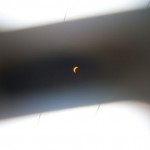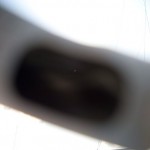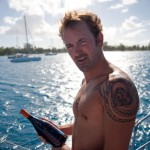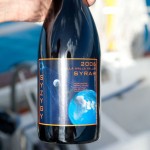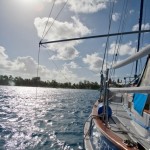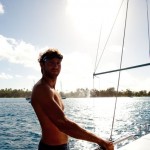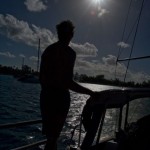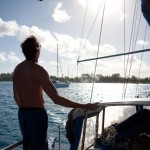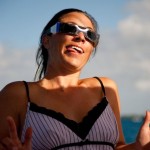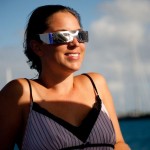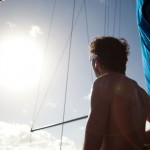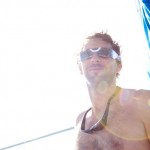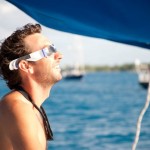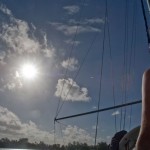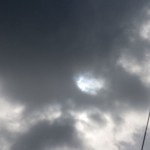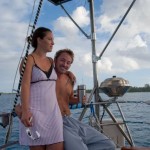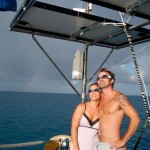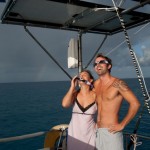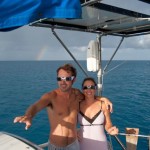Aug 10 2010
Misadventures with Slurpy Part 1
(refers to events on July 9th)
The dinghy has provided a constant source of amusement for us. Matt and Karen probably would chose a different word from ‘amusement’. Like ‘hatred’. This has only increased since I arrived.
Since we have an inflatable dinghy, it does not deal with rough water well. A hard bottom dinghy would do better. In rougher water with larger waves, larger being over 6 inches, a blast of water will spray up over the boat. The spray only increases with speed and wave height. Luckily our dinghy, handicapped as it is by a poor engine, never goes very fast.
I’ve noticed up until this point that to combat this spray, Matt or Karen will stand at the bow and pull up on a line connected to the bow. The idea is that you pull the bow up so that a: waves more easily pass underneath the dinghy and b: even if they don’t a higher bow will block some of the waves.
Now, I generally thought this dubious at best. The bow, in my opinion, seems to get pulled up about one inch. Better to just grin and enjoy the spray, a reminder that we are not cooped up in an office, working our 40 hour weeks, dressed in slacks and a button down, and paying lots of bills. However, on one fine day in Rangiroa, I decided to give my hand at trying this, if for no other reason than everyone else on our boat was doing it, so I wanted to be cool too.
As we pulled away from the dock, I grabbed the line and stood up. Another boat passes by. I note the wake (the waves eminating from behind the boat) they create, and think: not a problem. Their wake reaches us and rocks us side to side. I then think: this is a problem. I stumble from side to side, and as there is not much room side to side on our dinghy, I proceed to be clipped in the calf by the sides of the dinghy and tumble backwards overboard.
Man Overboard!
I am perfectly O.K. save a bruised ego, and once Matt has ascertained this he immediately starts laughing. I am not laughing. Not yet. I am frantically trying to get things out of my pockets that I don’t want to get wet. Money. My journal with months of entries I don’t want ruined. Two long letters to Allison. If those get wet, oh I would be so upset. Hence my franticness. However, the journal and letters are in a waterproof bag that I had remembered to seal, and the money was in a ziplock. After fishing those out of my pockets and realizing they were fine, I too laughed at myself, treading water and just laughing. Two cheapo glasses I had bought so you could look directly at the sun during the solar eclipse are within reach and I grab at them. The third has already started to float under. I pull myself back into the dinghy, sopping wet and laughing.
I take inventory and as Matt is starting to pull away, I realize I’m missing something. The handheld VHF radio. The extremely-nice-christmas-present-from-Matt’s-parents handheld VHF. Matt is displeased. Both of us without even telling the other simultaneously start trying to take a bearing on land. If you line up two points, say a pylon and a tree, then you return to this spot you can again line up the pylon and tree and know that you have returned to somewhere along that line. Do that with another 2 objects, preferably two which form a line perpendicular to the first two, and you have two lines which can only intersect in once point. Theoretically you can return to the same spot. As long as you don’t use a mooring ball which might move with a shift in wind and current. And you don’t forget what you used. Both of which happened to me.
After going to the boat to pick up snorkeling gear, we return to where we think I might have fallen in. I flop out of the dinghy, and swim around, frequently diving down to the bottom, it’s only about 15 feet, looking around. Matt moves around in the dinghy to scan a larger area, dunking his head in the water periodically. Ten minutes of searching. Twenty. Thirty. It seems inconceivable to me that we can’t find anything. I know other things fell out of my pockets.
And then I see the pair of glasses that had had been out of reach and sank to the bottom. Here’s the right spot!! Ten more minutes of searching. Search time no longer feels fruitless. The VHF must be here. I find a coin, 100 francs, about 1 US dollar, bright and shiny. This must have also fallen out of my pocket. And there is a AA battery I bought for the GPS. it must be here.
And finally there it was. A swell of relief first then a swell of apprehension. Would it work? I pop up out of the water. The smart thing would have been to take it back to the boat, rinse it with fresh water, let it dry out thoroughly, open it up and continue to ensure proper drying. I didn’t do that. It was still on, and so as soon as I popped up on the service and waved to Matt and pushed the boat to call Karen back at our boat. “Syzygy, Syzygy, this is Jon.” Karen replied. It worked. Thank you to Matt parents for buying such a nice VHF that it withstood being in 15 feet of water for over an hour! Misadventure part 1: a success!
